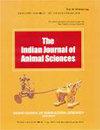Seasonal effect on the prevalence of virulence genes of non-O157 Verotoxic E.coli serogroups in faeces of cattle calves
IF 0.3
4区 农林科学
Q4 AGRICULTURE, DAIRY & ANIMAL SCIENCE
引用次数: 0
Abstract
Calves faecal samples (n=216) were investigated to observe the effect of seasons on the prevalence of serogroups and virulence genes of non-O157 VTEC. A total of 177 (81.94%) E. coli were isolated and 32 (14.81%) were identified as VTEC and serotyping resulted in 13 different non-O157 ‘O’ serogroups. The prevalence of serogroups and their virulence genes was found to be influenced by seasons and highest number were shed in summer (22.22%) followed by rainy (13.88%) and winter season (8.33%), respectively. A higher prevalence of O9 and O11 serogroups (25% each) was observed in summers. Molecular detection of virulence genes revealed the overall prevalence of vt1 to be 37.5%, vt2 43.8%, (vt1+vt2) 18.8%, eaeA 21.9% and hlyA 34.4% genes. Dominance of hlyA 50% was observed in summers, whereas vt1 and vt2 were more prevalent during rain (50% each). The study revealed the link between the occurrence of hlyA gene and O9, O11 serogroups in summers as both the serogroups were hlyA gene bearer. This association might be responsible for more VTEC outbreaks in summers. So, faecal contamination of raw milk seems to pose greater threat of non-O157 VTEC outbreak during hotter and humid months.季节对牛犊牛粪便中非o157 Verotoxic大肠杆菌血清群毒力基因流行率的影响
研究了犊牛粪便样本(216例),观察季节对非o157型VTEC血清群和毒力基因流行率的影响。共分离出177株(81.94%)大肠杆菌,其中32株(14.81%)为VTEC,血清分型结果为13个不同的非o157 ' O '血清组。各血清群及其毒力基因的流行受季节影响,以夏季最多(22.22%),其次为雨季(13.88%)和冬季(8.33%)。O9和O11血清群在夏季的患病率较高(各为25%)。毒力基因分子检测结果显示,vt1、vt2、(vt1+vt2)、eaeA、hlyA的总流行率分别为37.5%、43.8%、18.8%、21.9%和34.4%。夏季hlyA占50%的优势,而vt1和vt2在雨季更为普遍(各占50%)。该研究揭示了夏季hlyA基因与O9、O11血清群之间的联系,因为这两种血清群都是hlyA基因携带者。这种联系可能是夏季更多VTEC爆发的原因。因此,在炎热潮湿的月份,原料奶的粪便污染似乎对非o157 VTEC爆发构成了更大的威胁。
本文章由计算机程序翻译,如有差异,请以英文原文为准。
求助全文
约1分钟内获得全文
求助全文
来源期刊

Indian Journal of Animal Sciences
农林科学-奶制品与动物科学
CiteScore
0.60
自引率
25.00%
发文量
220
审稿时长
8 months
期刊介绍:
Articles published in The Indian Journal of Animal Sciences encompass a broad range of research topics in animal health and production related to cattle, buffalo, sheep, goat, camel, equines, pig, rabbit, yak, mithun, poultry and fisheries. Studies involving wildlife species and laboratory animal species that address fundamental questions about their biology will also be considered for publication. All manuscripts must present some new development and must be original, timely, significant and scientifically excellent. Papers will be rejected if standards of care of, or procedures performed on animals are not up to those expected of humane veterinary scientists. At a minimum, standards must meet the International Guiding Principles for Biomedical Research involving Animals, as issued by the Council for International Organizations of Medical Sciences. (C.I.O.M.S., c/o WHO, CH 1211 Geneva 27, Switzerland). Articles reporting new animal disease must follow GOI directive as given in detail in Guidelines to Authors.
 求助内容:
求助内容: 应助结果提醒方式:
应助结果提醒方式:


